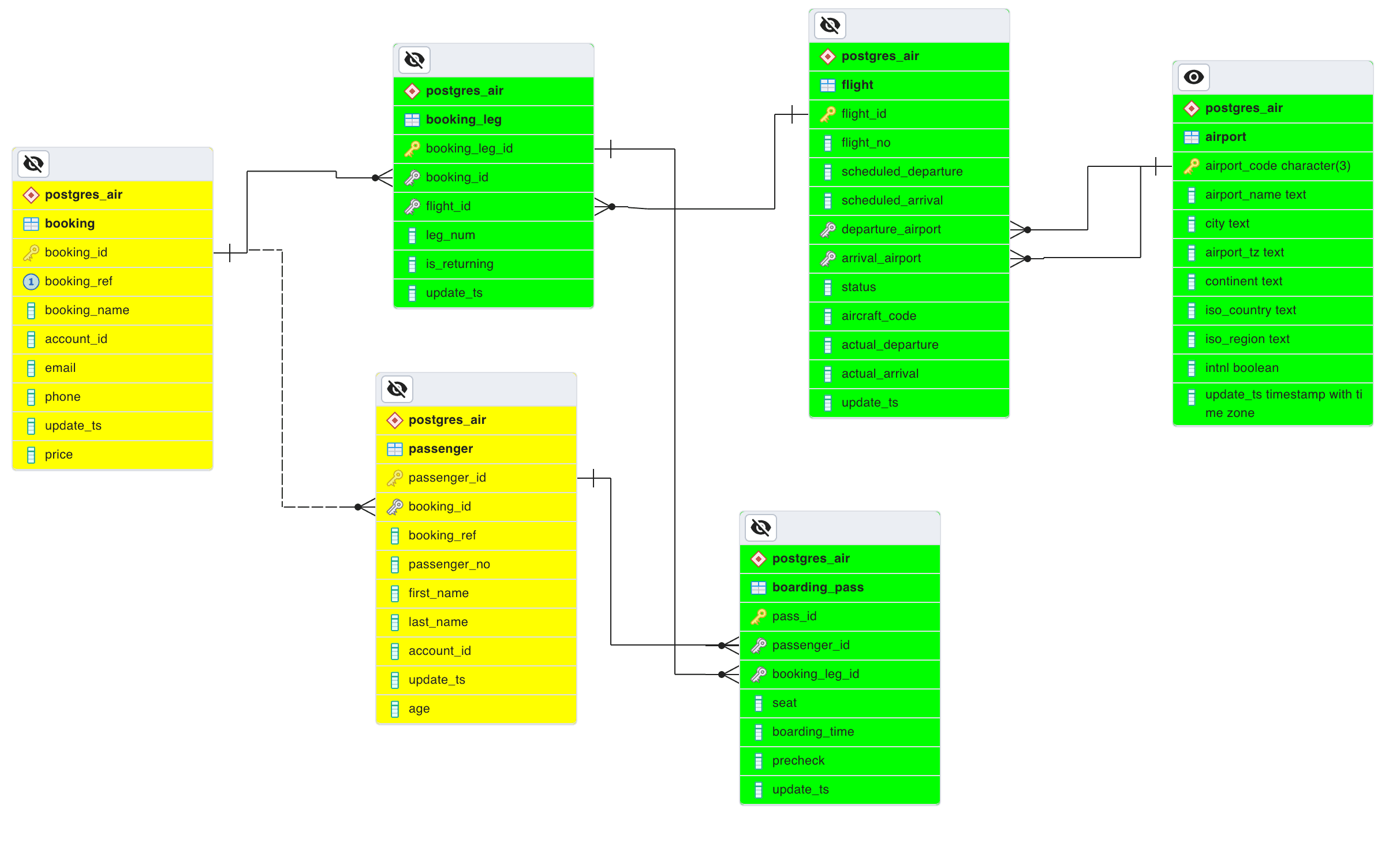Aggregation is a widely used way to summarize the content of a database. It is usually expressed with GROUP BY clause or just using aggregate functions (like COUNT or SUM). When the database engine executes a query with aggregations, it produces individual rows need to compute the required output and then performs the aggregation as (almost) last step. We discuss in this article how to re-write a query manually so that the order of operations will be different and when it can be beneficial.
We start with remainder that SQL is a declarative language, that is, a properly written query specifies what should be included into result but does not specify how to calculate this result. There are several ways (called execution plans) to do that for almost any query. All execution plans for a query produce same results but may utilize different amounts of computing resources. An optimizer tries to choose the best plan for execution. Usually, state-of-the-art optimizers do their job well but sometimes they fail to choose a good plan. This may happen for different reasons:
- The data statistics and/or cost model are imprecise.
- The optimizer does not consider some classes of plans.
In this article we discuss one type of query transformation that most optimizers do not use. Because of this, it can be beneficial for you to rewrite a query to help the optimizer order operations in a way that can be beneficial.
An analytical query is supposed to produce some kind of summary generalizing properties of huge amounts of data but at the same time should be compact and easy for humans to understand. In terms of the SQL query language this means that any analytical query extracts and combines large number of rows and then uses aggregate functions with or even without GROUP BY clause. More specifically, we consider queries that contain many JOIN operations followed by aggregation. Usually, queries are written in this way and, surprisingly, the optimizers choose the best order of joins but leave the aggregation as the last step.
Aggregation reduces the number of rows that will eventually be output from the query. Intuitively we can expect that it is possible to reduce the quantity of resources needed for execution if aggregates could be computed before joins. Of course, this is not always possible (for example when the argument of an aggregate function combines columns from joined tables), but even partial aggregation can reduce the cost significantly.
Our example uses the postgres_air database which can be downloaded from (https://github.com/hettie-d/postgres_air). You can download and restore the database if you want to execute any of the code in the article yourself.
The following ER diagram shows a subset of the tables in the postgres_air database that are important for our example. The tables that will be used in the example query are highlighted with the green background.

A row in the table booking represents a ticket. Each ticket is for one or more passengers and is linked to one or more flights. The table booking_leg is actually a relationship between the booking and flight tables. We do not need the booking and passenger tables in this example. A boarding pass is issued for each passenger, for each leg in the booking. We use a modified query discussed in [1, chapter 6]. The query returns the number of passengers departing from an airport during a month. To make results compact, the query returns5 airport-months with largest numbers of passengers:
|
1 2 3 4 5 6 7 8 9 10 11 12 13 14 15 16 17 18 19 20 21 22 23 24 |
air=# SELECT air-# a.city, air-# f.departure_airport, air-# to_char( air(# date_trunc(‘month’, scheduled_departure), air(# ‘Mon YYYY’) AS month, air-# count(passenger_id) passengers air-# FROM airport a air-# JOIN flight f ON a.airport_code = f.departure_airport air-# JOIN booking_leg l ON f.flight_id =l.flight_id air-# JOIN boarding_pass b ON b.booking_leg_id = l.booking_leg_id air-# GROUP BY city, f.departure_airport,month air-# ORDER BY passengers DESC air-# LIMIT 5; city | departure_airport | month | passengers -------------+-------------------+----------+------------ CHICAGO | ORD | Jul 2023 | 387568 CHICAGO | ORD | Jun 2023 | 352375 NEW YORK | JFK | Jul 2023 | 349624 LOS ANGELES | LAX | Jul 2023 | 325389 NEW YORK | JFK | Jun 2023 | 317593 (5 rows) Time: 23997.359 ms (00:23.997) |
The limit of the output to 5 rows does not significantly affect the execution time because the rows are sorted and, therefore, all rows must be produced.
When SQL query performance is discussed, the best place for a DBA to start is with analysis of the execution plan. So, the execution plans are included below. However, if you are not comfortable reading large execution plans but know or can believe that time needed for execution of a query depends mostly on the size of tables, you can skip the execution plan and go to a compact summary after the execution plan.
Even without any analysis we can guess that the number of boarding passes is significantly larger than the number of airports. This observation can be confirmed with an execution plan:
|
1 2 3 4 5 6 7 8 9 10 11 12 13 14 15 16 17 18 19 20 21 22 23 24 25 26 27 28 |
Limit (cost=8513712.70..8513712.73 rows=5 width=49) (actual time=25412.164..25412.781 rows=10 loops=1) -> Sort (cost=8513712.70..8576950.21 rows=25295004 width=49) (actual time=25412.163..25412.165 rows=10 loops=1) Sort Key: (count(*)) DESC Sort Method: top-N heapsort Memory: 26kB -> HashAggregate (cost=6698394.21..7967096.76 rows=25295004 width=49) (actual time=25411.676..25411.971 rows=2207 loops=1) Group Key: a.city, to_char(date_trunc(‘month’::text, f.scheduled_departure), ‘Mon YYYY’::text) Planned Partitions: 256 Batches: 1 Memory Usage: 1809kB -> Hash Join (cost=631461.30..1939771.59 rows=25295004 width=41) (actual time=2507.103..22475.673 rows=25293491 loops=1) Hash Cond: (f.departure_airport = a.airport_code) -> Hash Join (cost=631435.72..1746464.96 rows=25295004 width=12) (actual time=2505.722..12797.428 rows=25293491 loops=1) Hash Cond: (l.flight_id = f.flight_id) -> Hash Join (cost=604104.22..1451779.66 rows=25295004 width=4) (actual time=2344.625..8931.789 rows=25293491 loops=1) Hash Cond: (b.booking_leg_id = l.booking_leg_id) -> Seq Scan on boarding_pass b (cost=0.00..513758.04 rows=25295004 width=8) (actual time=0.661..1714.724 rows=25293491 loops=1) -> Hash (cost=310526.32..310526.32 rows=17894232 width=8) (actual time=2340.328..2340.328 rows=17893566 loops=1) Buckets: 262144 Batches: 128 Memory Usage: 7512kB -> Seq Scan on booking_leg l (cost=0.00..310526.32 rows=17894232 width=8) (actual time=0.016..1108.611 rows=17893566 loops=1) -> Hash (cost=15455.78..15455.78 rows=683178 width=16) (actual time=158.486..158.486 rows=683178 loops=1) Buckets: 262144 Batches: 8 Memory Usage: 6061kB -> Seq Scan on flight f (cost=0.00..15455.78 rows=683178 width=16) (actual time=0.049..72.871 rows=683178 loops=1) -> Hash (cost=16.92..16.92 rows=692 width=13) (actual time=0.380..0.380 rows=692 loops=1) Buckets: 1024 Batches: 1 Memory Usage: 39kB -> Seq Scan on airport a (cost=0.00..16.92 rows=692 width=13) (actual time=0.025..0.184 rows=692 loops=1) Planning Time: 4.381 ms Execution Time: 25414.796 ms (25 rows) |
The following table presents the essential data in more compact form:
|
|
|
|
|
|
|
|
|
|
|
|
|
|
|
|
|
|
|
|
|
|
|
|
|
|
254253 |
Each boarding pass row is counted exactly once, therefore, the number of rows after all joins is equal to the number of boarding passes. Boarding passes are issued not earlier than 24 hours before the departure. Therefore, there are no boarding passes for future bookings. For the same reason, the number of flights in the last row of the table is less than the total number of flights.
These observations suggest that we can try to reduce the number of rows after joining the two largest tables, namely, booking_leg and boarding_pass. The modified query looks somewhat more complicated but the execution time is significantly better:
|
1 2 3 4 5 6 7 8 9 10 11 12 13 14 15 16 17 18 19 20 21 22 23 24 25 26 27 28 29 30 31 32 |
air=# SELECT air-# a.city, air-# f.departure_airport, air-# to_char( air(# date_trunc('month', scheduled_departure), air(# 'Mon YYYY') AS month, air-# sum(cnt.passengers) passengers air-# FROM airport a air-# JOIN flight f ON airport_code = departure_airport air-# JOIN ( air(# SELECT flight_id, count(passenger_id) passengers air(# FROM booking_leg l air(# JOIN boarding_pass b USING (booking_leg_id) air(# GROUP BY flight_id air(# ) cnt air-# USING (flight_id) air-# GROUP BY city, f.departure_airport,month air-# ORDER BY passengers DESC air-# LIMIT 5; city | departure_airport | month | passengers -------------+-------------------+----------+------------ CHICAGO | ORD | Jul 2023 | 387568 CHICAGO | ORD | Jun 2023 | 352375 NEW YORK | JFK | Jul 2023 | 349624 LOS ANGELES | LAX | Jul 2023 | 325389 NEW YORK | JFK | Jun 2023 | 317593 (5 rows) Time: 11621.977 ms (00:11.622) |
Note that the intermediate grouping in this query is partial: it counts passengers on each flight but final grouping is still needed. The query returns exactly the same rows as the original one, but the execution time is below 12 seconds, while the original query took almost 24 seconds. This can be confirmed with the execution plan below (again, you can skip it if the difference in the execution time already convinced you):
|
1 2 3 4 5 6 7 8 9 10 11 12 13 14 15 16 17 18 19 20 21 22 23 24 25 26 27 28 29 30 31 32 |
Limit (cost=3148532.58..3148532.61 rows=5 width=73) (actual time=12714.984..12714.987 rows=10 loops=1) -> Sort (cost=3148532.58..3149070.53 rows=215179 width=73) (actual time=12714.982..12714.984 rows=10 loops=1) Sort Key: (sum(cnt.passengers)) DESC Sort Method: top-N heapsort Memory: 26kB -> GroupAggregate (cost=3137965.22..3143882.64 rows=215179 width=73) (actual time=12666.213..12714.380 rows=2207 loops=1) Group Key: a.city, (to_char(date_trunc('month'::text, f.scheduled_departure), 'Mon YYYY'::text)) -> Sort (cost=3137965.22..3138503.17 rows=215179 width=49) (actual time=12664.787..12694.274 rows=254253 loops=1) Sort Key: a.city, (to_char(date_trunc('month'::text, f.scheduled_departure), 'Mon YYYY'::text)) Sort Method: external merge Disk: 9944kB -> Hash Join (cost=2901980.71..3111548.55 rows=215179 width=49) (actual time=11307.355..12554.764 rows=254253 loops=1) Hash Cond: (f.departure_airport = a.airport_code) -> Hash Join (cost=2901955.14..3109878.78 rows=215179 width=20) (actual time=11306.626..12455.699 rows=254253 loops=1) Hash Cond: (cnt.flight_id = f.flight_id) -> Subquery Scan on cnt (cost=2874623.63..3076544.43 rows=215179 width=12) (actual time=11143.457..12204.002 rows=254253 loops=1) -> HashAggregate (cost=2874623.63..3074392.64 rows=215179 width=12) (actual time=11143.456..12193.799 rows=254253 loops=1) Group Key: l.flight_id Planned Partitions: 4 Batches: 5 Memory Usage: 8241kB Disk Usage: 344256kB -> Hash Join (cost=604104.22..1451779.66 rows=25295004 width=4) (actual time=2366.456..8823.030 rows=25293491 loops=1) Hash Cond: (b.booking_leg_id = l.booking_leg_id) -> Seq Scan on boarding_pass b (cost=0.00..513758.04 rows=25295004 width=8) (actual time=0.590..1697.414 rows=25293491 loops=1) -> Hash (cost=310526.32..310526.32 rows=17894232 width=8) (actual time=2362.140..2362.141 rows=17893566 loops=1) Buckets: 262144 Batches: 128 Memory Usage: 7512kB -> Seq Scan on booking_leg l (cost=0.00..310526.32 rows=17894232 width=8) (actual time=0.015..1113.579 rows=17893566 loops=1) -> Hash (cost=15455.78..15455.78 rows=683178 width=16) (actual time=162.236..162.236 rows=683178 loops=1) Buckets: 262144 Batches: 8 Memory Usage: 6061kB -> Seq Scan on flight f (cost=0.00..15455.78 rows=683178 width=16) (actual time=0.041..74.490 rows=683178 loops=1) -> Hash (cost=16.92..16.92 rows=692 width=13) (actual time=0.630..0.630 rows=692 loops=1) Buckets: 1024 Batches: 1 Memory Usage: 39kB -> Seq Scan on airport a (cost=0.00..16.92 rows=692 width=13) (actual time=0.024..0.299 rows=692 loops=1) Planning Time: 1.999 ms Execution Time: 12722.953 ms (31 rows) |
Any experienced DBA will notice that our execution plans do not contain enough information describing input/output needed for the query execution (such as number of buffers). There are two reasons for that:
- Both plans contain hash joins only, so each row of input tables is accessed only once for both queries and I/O is exactly same.
- Our queries are CPU-bounded, rather than I/O-bounded. There is no need to store any intermediate results between operations, and even sort uses main memory only.
So, is this kind of query transformations beneficial?
The answer is: it depends. Looking at the plan, if you compare the number of rows accessed to output the result, it is exactly as it was in the previous example. But the total costs were quite different:
Original query:
(cost=8513712.70..8513712.73 rows=5 width=49)
Rewritten query:
(cost=3148532.58..3148532.61 rows=5 width=73)
In the database folklore the JOIN operation is considered as a major resource consumer. However, the aggregation (grouping) has approximately same complexity as a join. This transformation includes additional grouping of a large table (or large intermediate result) in a hope to reduce complexity of subsequent join operations.
In our example the transformation reduces the number of rows from approximately 25 millions to 250 thousands. This reduction dramatically reduces the time needed for subsequent operations.
Transformation Rules
We are now ready to define the transformation rules. The query suitable for the transformation should contain joins followed by an aggregation (either GROUP BY or just returning one row), and the arguments of the aggregate functions must depend on a subset of joined tables. The code below is pseudocode, please do not try to execute it. We represent such queries in the following generic form:
|
1 2 3 4 5 6 7 8 |
SELECT ta.gr_attrib_a, tb.gr_attrib_b, agg_func(tb.table_b_attrib) FROM table_a ta JOIN table_b tb ON ta.join_attrib_a = tb.join_attrib_b GROUP BY ta.gr_attrib_a, tb.gr_attrib_b |
The result of the transformation of this generic query is:
|
1 2 3 4 5 6 7 8 9 10 11 12 13 14 15 |
SELECT ta.gr_attrib_a, tb.gr_attrib_b, agg_func1(tb.table_b_attrib) FROM table_a ta JOIN ( SELECT join_attrib_b, gr_attrib_b, agg_func2(table_b_attrib)as table_b_attrib FROM table_b GROUP BY join_attrib_b, gr_attrib_b ) subquery tb ON ta.join_attrib_a = tb.join_attrib_b GROUP BY ta.gr_attrib_a, tb.gr_attrib_b |
Informally, the transformation introduces additional grouping before the join. Aggregate functions needed after transformation may differ from the function in the original query (we discuss that later). Both table_a and table_b can be table expressions. Grouping and joining may involve multiple columns.
The table below shows how the example query from the previous section can be derived from the general form.
|
Aggregate Function |
COUNT (attributes) |
|
|
|
|
|
|
|
|
|
|
|
|
|
|
|
|
|
|
|
|
|
What about aggregate functions?
The example in the previous section uses COUNT as an aggregate function. In this section we provide transformation rules for other SQL aggregate functions.
We have already seen that for count in the original query agg_func1=sum and agg_func2=count. Functions SUM, MAX, and MIN are easy: agg_func1=agg_func2=agg_func for these functions. Indeed, these functions are commutative and associative. Therefore, arguments can be grouped arbitrarily in any order. The same applies also to the following aggregate functions available in PostgreSQL: bit_and, bit_or, bit_xor, bool_and, bool_or text.
The function AVG is trickier. By definition, the average is a ratio of sum of values to the quantity of these values, so the subquery can compute SUM and COUNT separately, and the final aggregation should divide sum of values by the sum of counts. However, the aggregate function sum ignores NULL values, while count(*) does not. Therefore, the correct expression should use count(column_in_sum). Also, the value of sum must be converted to float or double type before division.
|
1 2 3 4 5 6 7 8 9 10 11 12 13 14 15 16 17 18 |
SELECT ta.gr_attrib_a, tb.gr_attrib_b, case when sum(attrib_qty)> 0 then (sum(attrib_sum)::double)/sum(attrib_qty) else NULL end as avg_value FROM table_a ta JOIN ( SELECT join_attrib_b, gr_attrib_b, sum(table_b_attrib)as attrib_sum, count(table_b_attrib)as attrib_qty FROM table_b GROUP BY join_attrib_b, gr_attrib_b ) subquery tb ON ta.join_attrib_a = tb.join_attrib_b GROUP BY ta.gr_attrib_a, tb.gr_attrib_b |
An aggregate function that returns a concatenation of its input (such as string_agg, array_agg, xel_agg) depends on the order of rows and therefore cannot be used together with eager aggregation.
Yet another complication is the keyword DISTINCT that can precede the argument of any standard aggregate function. Again, functions max and min are easy as they are idempotent: the value of max or min remains same no matter how many times this value occurs as an argument.
Functions like (distinct attr_val) and sum(distinct attr_val) require preliminary aggregation on attr_val that actually removes duplicates.
Can an Optimizer Do This?
Looks like our transformation can be defined in a pretty formal way. It is known for very long time (see, for example, [2]. Can a database optimizer do this transformation automatically?
The answer is: yes, it can, but, most likely, the optimizer of your favorite RDBMS does not do it. In this section we discuss why developers of your favorite optimizer decided not to do that.
Most optimizers use some variations of the dynamic programming algorithm known since the late 70s. This algorithm finds the best (according to the value of the cost function) order of operations for SPJ (select-project-join) queries. Actually, handling of S and P is easy, so the optimization problem is also widely known as a problem of join order selection. In other words, such optimizers accept queries containing joins only. What to do with other operations? Some optimizers just split the query on SPJ parts and optimize them separately. For example, joins before and after the aggregation are optimized separately. We cannot see that from the execution plans, because the order is the same. However, in general our transformation may force early execution of some joins that the optimizer would execute later if all joins would be optimized together.
The benefits of our transformation are conditional: the cost of additional eager aggregation must be less than the gain on subsequent join operations due to reduction of the argument size. This means an increase in computational complexity that might be undesirable.
The good news is that researchers already found efficient techniques suitable for these kinds of query transformations, including more difficult transformations for outer joins and semi-joins [3]. We did not discuss joins other than inner in this article.
So, if your optimizer does not do eager aggregation yet, you can try doing it manually. Before doing it estimate how significant the reduction of size will be and choose the right place for eager aggregation. Most likely, the query that can benefit from eager aggregation contains joins of large and small tables. All large tables should be joined before the intermediate grouping.
References
- Henrietta Dombrovskaya, Boris Novikov, and Anna Bailliekova. Post- greSQL Query Optimization. Apress, 2021. URL: http://doi.org/10. 1007/978-1-4842-6885-8, doi:10.1007/978-1-4842-6885-8.
- Yan,W.,Larson,P.A.:Eageraggregationandlazyaggregation.In: Proceedings of International Conference on Very Large Data Bases (VLDB), vol 95, pp. 345–357 (1995)
- Marius Eich, Pit Fender, Guido Moerkotte: Efficient generation of query plans containing group-by, join, and groupjoin. VLDB J. 27(5): 617-641 (2018)





Load comments